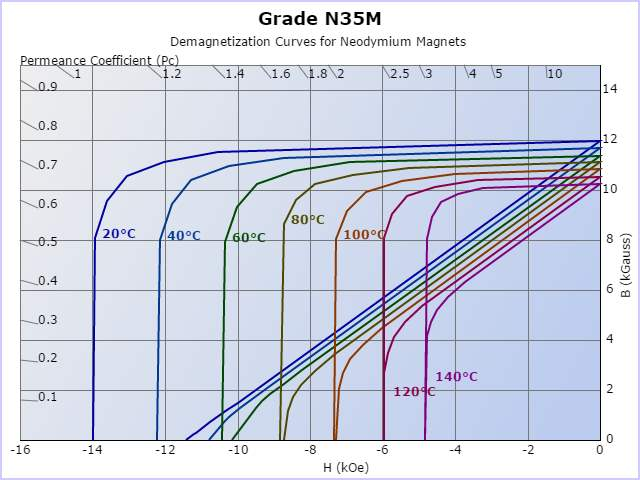Demagnetization Curve of Neodymium Magnets
Neodymium magnets, also known as NdFeB magnets, are powerful permanent magnets that have become essential in a wide range of industries, from automotive to electronics and renewable energy systems. While these magnets are known for their exceptional strength and performance, understanding how they behave over time, particularly in terms of their demagnetization curve, is vital to ensure long-term reliability.
The demagnetization curve of a neodymium magnet describes how the magnet's strength changes as external conditions, such as temperature or applied magnetic fields, affect it. In this blog, we will explain what a demagnetization curve is, why it's important, and how you can use it to maximize the performance of your neodymium magnets.
What is the Demagnetization Curve?
The demagnetization curve (or BH curve) of a magnet illustrates the relationship between the magnetic field strength (H) and the magnet's magnetic flux density (B) as it undergoes changes due to external forces. It helps determine how a magnet's performance changes when exposed to factors like temperature fluctuations, mechanical stress, and external magnetic fields.
A typical demagnetization curve shows a gradual decrease in magnetic strength (magnetic flux density, B) as the magnet is subjected to increasing external fields. The curve will eventually reach a point where the magnet's magnetic properties are irreversibly damaged—this is known as the coercive force. Beyond this point, the magnet may lose a significant portion of its magnetization.
Why is the Demagnetization Curve Important?
Understanding the demagnetization curve of a neodymium magnet is critical for several reasons:
- Preventing Premature Demagnetization: Knowing the demagnetization curve allows you to choose the appropriate magnet for your application. By selecting a magnet that operates within its optimal range, you can prevent premature loss of magnetic strength.
- Optimizing Magnet Performance: Understanding the curve helps you assess how much a magnet can tolerate in terms of external factors like temperature or external magnetic fields. This enables you to choose a magnet that will provide consistent performance over its expected lifespan.
- Selecting the Right Magnet for Specific Applications: Different applications have different environmental and operational requirements. By understanding how the demagnetization curve works, you can choose a magnet that will perform optimally under those specific conditions.
Factors That Affect the Demagnetization Curve
Several factors can influence the demagnetization curve of a neodymium magnet:
- Temperature: Neodymium magnets have a temperature coefficient, meaning their magnetic properties change with temperature. As the temperature increases, the magnet's ability to retain its magnetism decreases. For high-temperature applications, it’s essential to choose magnets with a higher maximum operating temperature to prevent demagnetization.
- External Magnetic Fields: If a neodymium magnet is exposed to strong external magnetic fields, it can result in magnetic saturation or damage to the magnet's internal structure. Understanding the coercive force on the demagnetization curve will help you avoid such issues.
- Mechanical Stress: Applying physical stress, such as pressure or impacts, can weaken the internal structure of the magnet, leading to a gradual loss of magnetic strength. Careful handling and proper installation are key to maintaining a magnet’s longevity.
How to Use the Demagnetization Curve to Your Advantage
To maximize the performance and lifespan of neodymium magnets, it’s essential to understand how to read and interpret the demagnetization curve. Here are some tips on how to use this knowledge to your advantage:
- Choose the Right Grade: Neodymium magnets come in various grades, such as N35, N42, N52, etc., each offering different coercive forces and magnetic strengths. By understanding the demagnetization curve, you can choose a grade that best suits the application’s requirements.
- Consider Environmental Factors: Always account for the environmental conditions where the magnet will be used. For high-temperature or high-stress environments, it’s critical to choose magnets with a higher coercive force and temperature stability.
- Regular Monitoring: If your application involves long-term use, it may be helpful to monitor the magnetic strength periodically, particularly if the magnet is exposed to extreme conditions. Regular checks will help identify any potential issues early on, preventing failure.
The demagnetization curve is an essential tool in understanding the behavior of neodymium magnets over time. By carefully selecting the right magnet based on its demagnetization characteristics, you can ensure the longevity and optimal performance of your magnets. Whether you're working in an industrial setting, electronics, or any other field, understanding the factors that affect demagnetization will help you make informed decisions about magnet selection and maintenance.
